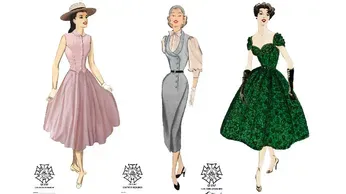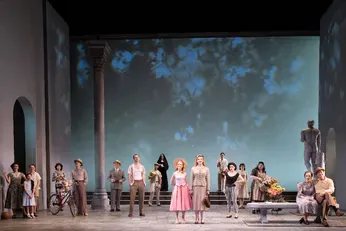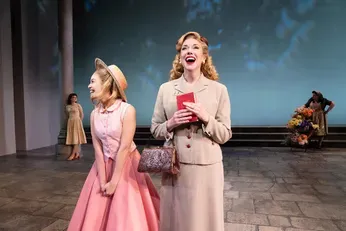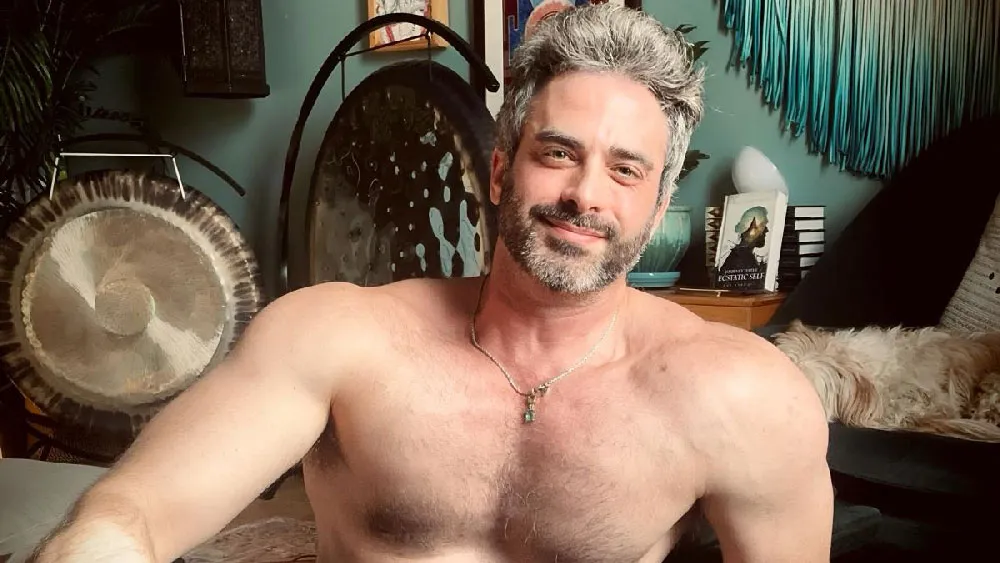
May 14
Alex Jaeger Heightens Emotions with His Costumes for 'A Light in the Piazza'
Kilian Melloy READ TIME: 8 MIN.
"The Light in the Piazza" started as a novella in 1960 by the writer Elizabeth Spencer before being adapted into the 1962 Guy Green-directed film starring George Hamilton, Yvette Mimieux, and Olivia de Havilland.
It tells the story of Margaret and Clara Johnson, an American mother and daughter on an extended trip in Italy. While sightseeing in the Piazza della Signoria, 26-year-old Clara Johnson falls for a Florentine man, Fabrizio. What isn't immediately clear to either Fabrizio or his family is that Clara's bubbly exuberance stems, at least in part, from a disability that has left her with a 10-year-old child's emotional and mental development.
25 years ago, composer/lyricist Adam Guettel (the son of composer Mary Rodgers and grandson to Richard) joined forces with queer playwright Craig Lucas ("Prelude to a Kiss," "Longtime Companion") to adapt the novel as a musical. After a couple regional runs, their musical opened at the Lincoln Center Theatre in April 2005 and ran nearly a year, winning six Tony Awards, including one for Guettel for his score and one for Victoria Clark in the demanding role of Margaret. In the musical, she must decide what's best for her daughter – can she leave her in Florence or, as her husband demands, have her return to the States for special care?
With its heady, operatic score and the emotional depth of its book, "The Light in the Piazza" is often cited as one of the best musicals of the 21st century. It's not surprising to see it turn up in opera houses, as it did in 2019 when Renee Fleming starred in a production at the LA Opera.
Watch this mini-documentary of the production of "The Light in the Piazza" at the Huntington Theatre Company
Boston audiences have their opportunity to see the musical as the Huntington Theatre Company closes it season with a production through June 15. Loretta Greco – the Huntington Norma Jean Calderwood artistic director – helms the production, in which Emily Skinner stars as Margaret, Sarah-Anne Martinez as Clara, and Joshua Grosso as Fabrizio, with William Michals (Signor Naccarelli), Rebecca Pitcher (Signora Naccarelli), Alexander Ross (Giuseppe Naccarelli), and Rebekah Rae Robles (Franca Naccarelli) rounding out the principal cast.
It's not just a story of youthful love in its first flush. Each of the principal characters has a love story of a different sort, as Margaret makes an unexpected connection with Signor Naccarelli while Fabrizio's brother, Giuseppe, and his wife, Franca, struggle with unhappiness in their marriage. Permeating everything is "the light in the piazza" – the light that was Clara's unreserved radiance and joy the moment Fabrizio saw her in the plaza, and that drives back the shadows of everyone else's doubts.
EDGE caught up with the production's costume designer, Alex Jaeger, to talk about the art of costuming, contemporary resonances in this historically set romance, and... of course... the Italian art of the bella figura, the beautiful figure, which is as wrapped up in style as a Florentine supermodel.

EDGE: "The Light in the Piazza" is a love story set in Italy in 1958 in Italy. What do you expect will resonate with contemporary audiences?
Alex Jaeger: Without giving too much away, there is a theme of perceptions of people who are differently abled, and how there's a lot of fear and hiding – and also, ultimately, acceptance when you speak your truth. Other than that, it has really beautiful music, amazing singers, and, yeah, a love story.
EDGE: The parents on both sides of a young couple – Fabrizio and Clara – come up with reasons why they think it's not in the best interest of their children to have a romance. It reminded me of the patronizing rationales we hear directed at the queer community when we're told who we can marry, who we can't marry, why we shouldn't marry, etc. Would you say there's a metaphor there?
Alex Jaeger: I think so, and one of the lessons to be learned is that, in trying to hide and cover up and second guess what other people are going to think, that brings even more misunderstanding. Once the truth comes out, everybody is like, "What was the big deal?," and they get to move forward with their happy lives that could have been denied just because of secrets and misunderstandings.
EDGE: How is costuming different when you're dealing with a musical, versus a straight play?
Alex Jaeger: Musicals, just by their very nature, are heightened reality. A lot of people who don't like musicals say, "Well, it doesn't make any sense that people just suddenly burst out singing," but my view on that is that we all know the way that music makes us feel. Adding that to a storyline heightens the emotions in the story. I feel like that gives me a bit of leeway to be a little more heightened in the in the design, as well.
EDGE: What was it like to be doing research into what Italian and American clothing would look like right after World War II?
Alex Jaeger: We have a lot of street scenes in this show, so Loretta Greco, our director, was very interested in having a cross-section of different social standings. So, we have some street vendors, and we have religious figures, and we have wealthy folks. It was fun doing the research just to see all the different aspects of that, but it's always harder to find pictures of average people, especially from another country.

EDGE: There's a scene set in the clothing shop of Fabrizio's father, Signor Naccarelli, where his brother Giuseppe, and father are helping him to look nice. That blend of costuming and comedy must have been fun to plan out.
Alex Jaeger: It is fun, and especially because Fabrizio is sort of clueless – his family's in the fashion business, but he doesn't really follow that. He goes to the shop hoping to look better, but it doesn't really work because he's got his basic clothes on, and then he puts on his brother's jacket, which doesn't really fit, and they grab a tie off the wall that doesn't really match. It's a playful scene in that they're kind of teasing him.
EDGE: Italians are very much into their bella figura. And speaking of Italian turns of phrase, there's a lot of dialogue and song lyrics that are left untranslated – did you translate that to help with your thinking about how these people should look?
Alex Jaeger: I somehow got a translation, and I understood enough Italian. I think it's well constructed in that, even if you don't speak Italian, you can follow the story and you know what's going on. The way that things are said in Italian, somebody will either respond, or repeat it, in English, so that you know what was said.
EDGE: There are so many characters with such distinctive ages and backgrounds that it must be a thrill, but also a huge challenge, to create all the costumes for even one scene – and you have lots of scenes to think about.
Alex Jaeger: Yeah, and we have a very large ensemble, and they all play six, seven, eight different roles. We have racks and racks and racks of costumes. Also, as the show progresses the scenes, even for the principals, don't really allow much repeating, because [Margaret and Clara] are sightseeing in one scene, and then [everyone is] at a tea, and then they're in church, and then they're doing other things, so it's not like they can each have one [outfit]. They all have six or seven looks, so it's a lot.
EDGE: It's interesting how much about a play or a movie or a TV show comes down to the costuming, but it seems like costumers don't get a lot of the attention or a lot of the kudos.
Alex Jaeger: Yeah, costuming has historically been very underrated. A lot of people attribute that to the fact that it's clothes and sewing, or seen as women's work. Costumers generally get paid a lot less, and they're lower down in the credits, unless you're an Oscar winner. It can be frustrating. Sometimes a period show, or a splashy kind of show, does get attention [for costuming], but doing really great "poor people" clothes or contemporary stuff is difficult, too, and that is usually not very well recognized.
EDGE: For a big production like this, are you and your team creating everything bespoke, or are you also relying on secondhand sources or rentals?
Alex Jaeger: The shop here at the Huntington is unbelievable. They're so talented and so great, but other than a Broadway show, there really isn't a theater in America that would produce everything for a big show. It's a combination of building things and renting things. I live in LA, and so I did a lot of vintage shopping there and had everything shipped out. The trick is to try to make the new stuff and the vintage stuff look seamless, but that's hard.
EDGE: What might you have coming up in terms of projects that have you excited about costuming challenges or costuming possibilities?
Alex Jaeger: I've worked for many, many years with Loretta Greco, and she brought me in to do several things at the beginning of the season. We did "Leopoldstadt," which was a new version that the director, Carey Perloff, and [playwright] Tom Stoppard worked on to make it more producible, because The London/Broadway version was very unwieldy. I think we were very successful on that production. The next production of that is coming up in Chicago, and I'm going to go there with Carey Perloff and design that.
When I go back to L.A., I'm working on a musical about female Supreme Court justices. It's a small costume challenge – it's mostly the black robes and a couple of suits – but I think it's an interesting project, and will probably be very timely.
"The Light in the Piazza" runs from May 9 - June 15 at The Huntington Theatre. For tickets and more information, follow this link.
Kilian Melloy serves as EDGE Media Network's Associate Arts Editor and Staff Contributor. His professional memberships include the National Lesbian & Gay Journalists Association, the Boston Online Film Critics Association, The Gay and Lesbian Entertainment Critics Association, and the Boston Theater Critics Association's Elliot Norton Awards Committee.







